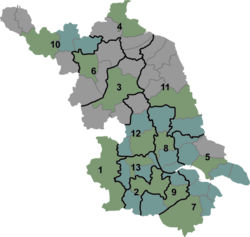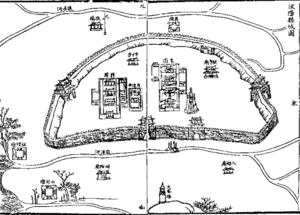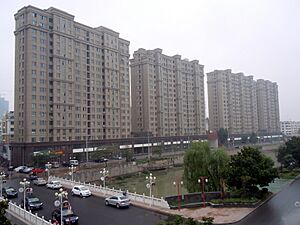Shuyang County facts for kids
Quick facts for kids
Shuyang
沭阳县
|
|
|---|---|
|
County
|
|

Shuyang County in July 2011
|
|
| Country | People's Republic of China |
| Province | Jiangsu |
| Prefecture-level city | Suqian |
| Established | 582 BC |
| Government | |
| • Type | Province Managing County |
| Area | |
| • County | 2,298 km2 (887 sq mi) |
| Population
(2019)
|
|
| • County | 1,930,000 |
| • Density | 839.9/km2 (2,175/sq mi) |
| • Urban | 650,000 |
| • Metro | 650,000 |
| Time zone | UTC+8 (China Standard) |
| Postal code |
223600
|
| Area code(s) | 527 |
| GDP | ¥63.01billion (2015) |
| Major Nationalities | Han |
| Township-level divisions | 34 |
| License Plate | 苏N |
| Shuyang County | |||||||
|---|---|---|---|---|---|---|---|
| Traditional Chinese | 沭陽 | ||||||
| Simplified Chinese | 沭阳 | ||||||
|
|||||||
Shuyang (simplified Chinese: 沭阳县; traditional Chinese: 沭陽縣; pinyin: Shùyáng Xiàn) is a county in northern Jiangsu province. It is under the administration of the prefecture-level city of Suqian. Shuyang sits on the Northern Jiangsu Plains and borders the cities of Xuzhou, Lianyungang, and Huai'an to the north, east, and south.
Shuyang is a pilot administrative division for "provinces governing county level units directly" in Jiangsu, along with Kunshan and Taixing.
Contents
Etymology
The name of “Shuyang” was first officially used in 549 AD during Eastern Wei.
The two Chinese characters in the county's name are “沭” and “阳”, together meaning “in the north of the Shu River”. As the government and commercial center, the county seat was chosen to be constructed in the north of Shuhe River in 549 AD in order to control the land around the river basin.
History
Prior to its proclamation as the Zhou Dynasty in 1111 BC, the area around the north of Jiangsu was inhabited by the Dongyi, an ancient ethnic group that established numerous city-states. The area around Shuyang belonged to Tan (郯), one of the Dongyi states.
In the late period of the Zhou Dynasty, that is Spring and Autumn period, the State of Lu began to expand its power to the south. Part of the region was officially proclaimed as the territory of the State of Lu in 582 BC after the fortress "Zhongcheng" (中城), was built on the northwest. This is also the first city in this place in accordance with ‘The Spring and Autumn Annals’, which was compiled by Confucius. In the Warring States period, the Chu conquered and controlled the land of this area.
After Qin's wars of unification, the Qin Dynasty was established by Qin Shi Huang, the first emperor of China. Houqiu County (厚丘县) was founded for administrating the region and the governments of later dynasties generally followed this pattern.
In 549 AD, the imperial government of Eastern Wei abandoned the old castle and city wall and moved the local government into a new county seat near the north of Shu River. In the meantime, the county was changed to the present name, Shuyang County (沭阳县). In the following 1400 years, the location of the county seat was kept constant.
As the main natural disaster in northern Jiangsu, rain storms and floods were the principal threat to the county in the old days. The castle and city wall of Shuyang was totally destroyed up to the middle of the 15th century. The government rebuilt the city wall until 1512 and was ruined by the floods subsequently. In 1594, the local government started to rebuild a substantial one with plenty of bricks and stones and it was finished in 1616.
In the early modern period, life in this region was recognised as peaceful and stable for most of the time.
The area was invaded by Imperial Japan in 1937. The ancient city wall and other pieces historic architecture were devastated at the beginning of the war.
Geography
Shuyang is in the North China Plain, located approximately 260 kilometres (160 mi) from Nanjing, and 450 kilometres (280 mi) from the center of Shanghai. The county stretches 60 kilometres (37 mi) from east to west, and 55 kilometres (34 mi) from north to south.
Shuyang is located in a low-lying plain, with most of its elevation reaching just 4.5 metres (15 ft) to 7 metres (23 ft) above sea level. Mount Han (Chinese: 韩山; pinyin: Hán Shān) is the highest point in Shuyang County, with an elevation of 70 metres (230 ft) above sea level. It is located within the east of the county, in the town of Hanshan.
Climate
Shuyang has a distinct four-season, monsoon-influenced humid subtropical climate with hot, humid summers, and generally mild, dry winters (Köppen climate classification Cfa).
Winters are generally mild and dry. However, cold northwesterly winds from Mongolia and Siberia can cause temperatures to drop below freezing in the night, and there has been occasional snowfall in winters in recent years. Summers are hot and humid; southeasterly winds during the summer can push temperatures above 35 °C (95 °F). In midsummer, occasional downpours or thunderstorms can be expected.
| Climate data for Shuyang (1991–2020 normals, extremes 1981–2010) | |||||||||||||
|---|---|---|---|---|---|---|---|---|---|---|---|---|---|
| Month | Jan | Feb | Mar | Apr | May | Jun | Jul | Aug | Sep | Oct | Nov | Dec | Year |
| Record high °C (°F) | 17.2 (63.0) |
25.6 (78.1) |
27.0 (80.6) |
31.4 (88.5) |
36.4 (97.5) |
37.5 (99.5) |
38.9 (102.0) |
36.6 (97.9) |
34.8 (94.6) |
33.5 (92.3) |
27.6 (81.7) |
20.4 (68.7) |
38.9 (102.0) |
| Mean daily maximum °C (°F) | 5.8 (42.4) |
8.8 (47.8) |
14.1 (57.4) |
20.4 (68.7) |
25.5 (77.9) |
29.5 (85.1) |
31.0 (87.8) |
30.5 (86.9) |
27.0 (80.6) |
22.0 (71.6) |
14.9 (58.8) |
8.1 (46.6) |
19.8 (67.6) |
| Daily mean °C (°F) | 0.8 (33.4) |
3.5 (38.3) |
8.4 (47.1) |
14.6 (58.3) |
20.0 (68.0) |
24.2 (75.6) |
27.0 (80.6) |
26.3 (79.3) |
22.0 (71.6) |
16.2 (61.2) |
9.4 (48.9) |
2.9 (37.2) |
14.6 (58.3) |
| Mean daily minimum °C (°F) | −3.0 (26.6) |
−0.7 (30.7) |
3.7 (38.7) |
9.4 (48.9) |
14.9 (58.8) |
19.8 (67.6) |
23.8 (74.8) |
23.2 (73.8) |
18.2 (64.8) |
11.7 (53.1) |
5.1 (41.2) |
−1.0 (30.2) |
10.4 (50.8) |
| Record low °C (°F) | −15.6 (3.9) |
−17.1 (1.2) |
−9.6 (14.7) |
−1.2 (29.8) |
3.3 (37.9) |
9.9 (49.8) |
17.7 (63.9) |
14.2 (57.6) |
7.5 (45.5) |
−1.4 (29.5) |
−7.6 (18.3) |
−18.0 (−0.4) |
−18.0 (−0.4) |
| Average precipitation mm (inches) | 22.9 (0.90) |
26.2 (1.03) |
36.9 (1.45) |
50.6 (1.99) |
71.3 (2.81) |
124.6 (4.91) |
210.7 (8.30) |
194.4 (7.65) |
84.4 (3.32) |
38.5 (1.52) |
35.6 (1.40) |
20.9 (0.82) |
917 (36.1) |
| Average precipitation days (≥ 0.1 mm) | 4.7 | 5.6 | 6.4 | 6.7 | 8.1 | 8.3 | 13.3 | 12.4 | 7.8 | 5.7 | 5.8 | 4.5 | 89.3 |
| Average snowy days | 2.6 | 2.2 | 0.9 | 0 | 0 | 0 | 0 | 0 | 0 | 0 | 0.5 | 1.2 | 7.4 |
| Average relative humidity (%) | 69 | 68 | 66 | 67 | 72 | 75 | 84 | 85 | 80 | 74 | 72 | 69 | 73 |
| Mean monthly sunshine hours | 142.5 | 140.4 | 174.5 | 198.2 | 208.0 | 166.6 | 163.8 | 167.9 | 170.8 | 171.3 | 147.7 | 146.3 | 1,998 |
| Percent possible sunshine | 45 | 45 | 47 | 51 | 48 | 39 | 38 | 41 | 47 | 49 | 48 | 48 | 46 |
| Source: China Meteorological Administration | |||||||||||||
Administrative divisions
Shuyang County administers 6 subdistricts, 23 towns, 1 township, and 2 other township-level divisions.
Subdistricts
The county administers the following 6 subdistricts:
- Shucheng Subdistrict (沭城街道)
- Shizi Subdistrict (十字街道)
- Nanhu Subdistrict (南湖街道)
- Zhangji Subdistrict (章集街道)
- Mengxi Subdistrict (梦溪街道)
- Qixiong Subdistrict (七雄街道)
Towns
The county administers the following 23 towns:
- Longji (陇集镇)
- Liheng (李恒镇)
- Huji (胡集镇)
- Zhaxia (扎下镇)
- Qianji (钱集镇)
- Yanji (颜集镇)
- Tanggou (塘沟镇)
- Tongyang
- Machang (马厂镇)
- Longmiao (龙庙镇)
- Yitao (沂涛镇)
- Gaoxu (高墟镇)
- Miaotou (庙头镇)
- Gengwei (耿圩镇)
- Hanshan (韩山镇)
- Xinhe (新河镇)
- Huachong (华冲镇)
- Xianguan (贤官镇)
- Sangxu (桑墟镇)
- Wuji (吴集镇)
- Yuelai (悦来镇)
- Qingyihu (青伊湖镇)
- Liuji (刘集镇)
Townships
The sole township in Shuyang County is Xixu Township.
Other township-level divisions
Shuyang County also administers the Shuyang Economic and Technological Development Zone and the Kunshan Industrial Park (昆山工业园区).
Demographics
As of 2010, Shuyang County had a population of approximately 1.83 million, making it the most populous county in Jiangsu. Shuyang had a metropolitan population of more than 560,000, according to the 2010 Chinese Census. Major areas of population growth in recent years were in suburbs like Nanhu and Mengxi, which are now a part of the metropolitan area. In 2015, the urban area was expected to have a population of approximately 800,000. Some 30% of the population of the whole region are residents of the metropolitan area.
Economy
During the Republic of China, the economy of Shuyang County was negatively impacted by the Japanese invasion of China and frequent floods. In the 1950s, the local economy developed rapidly, benefitting from the post-war recovery and further development of agriculture and industry in the region. However, Shuyang County was of decreasing economic importance within Jiangsu from the time of the Cultural Revolution onwards. In 1997, under the administration of Qiu He, the government of Suqian, which governs Shuyang County, began undergoing economic reforms focusing on industrialization and privatization.
As of 2018, Shuyang County had a total gross domestic product (GDP) of more than 80 billion renminbi (RMB).
Mineral resources within Shuyang County include kyanite, quartz, and clay. The county's kyanite reserves account for about a quarter of China's national reserves.
Agriculture in Shuyang County is highly digitalized, and the county is home to numerous so-called "Taobao villages", where a large portion of the rural population is highly engaged in e-commerce.
Culture
Dialect
There are over 1.7 million people in Shuyang who speak a subdialect of Lower Yangtze Mandarin, called Haisi Dialect. Like most of Lower Yangtze Mandarin, Haisi dialect has five tones due to the preservation of the entering tone (Chinese: 入声; pinyin: rù shēng) of Middle Chinese, more than the four-toned Standard Chinese which lost the entering tone. The dialect of Haisi has largely lost the initial n, replacing it with l, and the retention of the entering tone sets it apart from other Mandarin dialects.
Speakers of the dialect can easily understand other varieties of Mandarin, but not vice versa. As Standard Chinese becomes increasingly powerful in social life, it has largely impacted on the dialect in words, pronunciation, and grammar.
Religions
Approximately 95% of the population of Shuyang County expressed no religious affiliation, according to the 2010 Chinese Census.
Buddhism
It has been unverified when the Buddhism was first introduced to Shuyang County. It might have been introduced to this region around the 2nd century to the 3rd century by sea. The oldest temple in Shuyang is the Qingliang Temple, which was built before the 9th century.
Christianity
In 1921, the Presbyterian Church in the United States started missionary work in Shuyang County. The current church was built in 1993 in the north of the urban area. The second church was to be opened in 2014.
Opera
Huaihai opera is sung in the region.
Transportation
Major roads which run through Shuyang County include the G2 Beijing–Shanghai Expressway, China National Highway 205, and Jiangsu Provincial Roads 245, 304, 324, and 326.
The Xinyi–Changxing railway runs through Shuyang County. The railway connects the Longhai railway and Jiaozhou–Xinyi railway in the north with the Nanjing–Qidong railway, Beijing–Shanghai railway, and Xuancheng–Hangzhou railway in the south. Shuyang railway station, near the metropolitan area, is a third class station on the Xinyi-Changxing Railway.
Navigable rivers within Shuyang County include the Shu River, the Shuxin River, the Liutang River (Chinese: 六塘河; pinyin: Liùtáng Hé), the Qiangwei River, and the Gupo River (Chinese: 古泊河; pinyin: Gǔpō Hé). The Lianyungang-Suqian Canal connects the Lianyungang Port and the Grand Canal is under construction.
Sister cities
- Domestic




